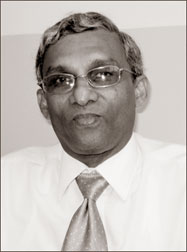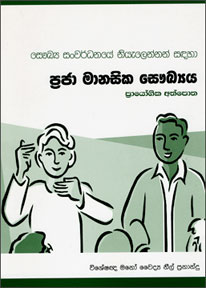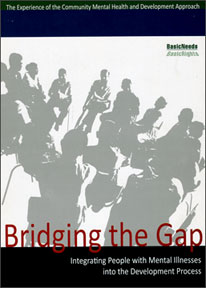 Surpassing artificial barriers Surpassing artificial barriers
Integrating people with psychiatric disorders into
the development process:
What is the level of success you have achieved in your approach to
integrate people with mental illness into the development process?
|

Dr. Neil Fernando
Consultant Phychiatrist
|
When it comes to Mental Health Services in the State Sector,
concentration is more on prescribing medicine than on the patient.
Patients are assessed, diagnosed and simply discharged. But there is no
mechanism to re-integrate these persons into the society. That is to
help them to become independent and to have a means of generating
income.
So they are left to themselves. On the other hand, the societal
attitudes of persons with psychiatric disorders or even those who were
fully-recovered are not conducive to their re-integration. This
important aspect has been neglected in the State Sector.
Therefore, the combination of mental health and development is needed
so that persons once recovered from psychiatric disorders will be able
to stand on their feet and to make a contribution to the society.
Unfortunately, at the moment, we do not have such a mechanism in place
in Sri Lanka.
What are the kinds of support you offered when you conducted
workshops in affected communities?
In the programme we launched in Southern Province, we applied this
concept of mental health and development. We went beyond the area of
illness. Because of the volunteers chosen from the community, it became
easy for us to integrate persons with psychiatric disorder into the
development process and to get rid of the social stigma attached to
them.
In addition, volunteers look after the patient during and after the
treatments. There were income generating projects such as home
gardening, small-scale enterprises (persons were trained by experts for
the business) so that persons once-recovered are able to engage in
income generating activities.
 |
 |
|
Recently launched hand
books for the public. These books are available in Tamil medium
also. |
We have also seen the success of the programmes as those who engaged
in the programmes were able to become financially independent which in
turn improve their mental health.
This programme also offered opportunities for the ex-patients to
participate in community programmes such as in religious functions.
This gave opportunity for them to make use of their talents and to
work hand in hand with healthy persons.
Another positive outcome of the programme was the formation of
Consumer Action Forum (CAF), perhaps, first kind of such organisation.
CAF promotes mental health in new areas we worked and this led to de-stigmatising
and lessoning the discrimination against persons with psychiatric
disorders. Self-help groups consisting of six to eight individuals were
also formed during the programme.
What is the pro-active role that a self-help group can play in
improving the standards of people with psychiatric disorders?
A Self-help group is made up of a consumers, care-givers and
volunteers who are interested in caring for the person with psychiatric
disorders. So these Self-help groups meet once a month at a member’s
home.
During the meeting, they discussed their problems and find solutions
for them. As they are differently-abled, the individuals with skills
train other members in the group.
These Self-help groups also help individuals outside their groups.
Through Self-help groups, these individuals learn to rely on themselves
rather than on outside factors, increasing their self-esteem and
self-confidence. Self-help groups make people more resilient and more
confident.
How does spiritual and cultural interventions help this process
which culminates in integrating people with psychiatric disorders into
development process?
Culture and spiritual aspect is very important. Especially our
culture provides a lot of psychological mechanisms to protect people.
For instance, our funeral rituals and religious rituals associated
with funerals are, in fact, psychologically beneficial and helpful for a
grieving person to overcome that grief. That is why we saw even after
Tsunami a lot of people withstood the shock as a result of this support
of the culture. Cultural and spiritual practices occupied a prominent
place in the programme.
There is spiritual dimension to health. Whatever your religion,
religious practices affects your well-being. Be at individual level or
family level or at community level, individuals were encouraged to
practice their religion. We even had a spiritual counselling in the
health camps we conducted once a month.
We found that spiritual counselling sessions were helpful especially
for Buddhists. Buddhist-psycho-therapy was practised. As individuals
practice religion, spiritual aspects help them in times of distress.
How does music and other forms of performing Arts help to manage
stress even for healthy individuals?
Art can definitely be used as a form of expression and we know that
in certain psychological disturbances, it is common practice to
encourage expression of emotions. It itself is therapeutic.
There is a psychological term Catharsis which means bringing out
emotions of psychologically disturbed person and arts can be used as a
form of an expression. Arts Therapy is a form of therapy where people
are encouraged to express their emotions through arts.
This is frequently used for children. Another common application is
drama; psycho-drama where people acting out their difficulties and
problems. We have not yet used music therapy. Arts and Literature are
definitely used as psycho-therapies.
Did you create a support network of volunteers who will look after
the aspects of rehabilitation and effective integration of people with
psychiatric disorders into the process?
Networking is a process through which individuals are bringing
together people with common problems and getting them not only to share
their experiences but also their skilling in coping with their problems.
For example, we used this for certain diagnostic categories such as
people who were suffering from depressive disorder. Another group was
persons suffering from epilepsy. Networking helps them to learn and
share their experiences.
The members of the group also became supportive of one another.
Networking is helpful therapeutically not only for patients or consumers
but also for care-givers. It is also important for care-givers as they
should be prepared to provide care for patients.
Why did you describe that community-led intervention is a
composite approach rather than a single approach?
The community is consisted of three categories, patients or
consumers, care-givers and volunteers who are prepared to sacrifice some
time for consumers. What is important is community participation.
It should not be the name-sake participation. Active community
participation covers four main areas; planning, implementation and
monitoring and evaluation of programmes.
In the planning stage of a programme, the community should carry out
need-assessment, prioritizing the needs and working out a Community
Mental Health Plan.
This is done in a Consultative Workshop, a one day programme
conducted in the community. At the end of the programme, there will be
volunteers and the community engaging in the implementation of the
Community Mental Health Plan.
We have observed three broad categories of needs in Consultative
Workshops; medical and therapeutic needs, public education (about
illness and care-giving) and support (financial support and other forms
of support).
It was a bottom-up approach. The Village Mental Health Committee
implemented the programmes. It also monitored and evaluates the progress
in addition to evaluation by outsiders. Outside evacuation was also done
in this programme, in order to get an independent view.
What are the challenges encountered in the application of the
community-led intervention?
Initially, there were many challenges. One of the challenges was the
faith in the programme. However, they were proved capable of
identifying, implementing their needs at the Consultative workshop.
Though sustainability was challenged, sustainability was maintained as
community thoroughly involved in the programmes. Another challenge
remaining is that to implement this programme at national level.
Can you describe the children-led interventions?
Children were also involved in the programme at all stages. In order
to get them to participate, Children’s Clubs were formed. This was done
especially following Tsunami, in affected areas. Children even organised
“Adventure Day”. Children-led activities included organizing plays,
“Adventure Days”, taking part in days of national and religious
significance. Children themselves organised these programmes.
What are the positive outcomes of the workshops?
The de-stigmatising and non-discriminating persons with psychiatric
disorders are among positive outcomes of the programme which created the
environment.
The other important aspect is providing opportunities for
once-patients to come out and to engage in the community as productive
citizens. Third positive outcome is the formation of the Consumer Action
Forum (CAF) so that mentally ill persons get together and be a voice of
their own. For example, in hospitals in one of the areas where we worked
did not have any nurses.
Even the Provincial Director of Health was unable to provide nurses
for the hospital. But CAF was able to advocate the necessity of having
nurses in the hospital. They met the Provincial Director and were able
to get down nurses for that hospital within a short period of time.
Another important aspect of the programmes was that the integration of
Government sector and non-government sector for a common purpose.
There was an integration and inter-sectoral cooperation for a long
time on a sustainable basis. Ultimately, it was a shared responsibility.
One sector complements the other.
What are the future interventions that you envisage?
To make it a national programme is very important and that kind of
experience gained should be shared by policy makers through training
programmes; training of doctors, nurses and other categories would be
beneficial. Training should include skilling in inter-personal
relations. |
